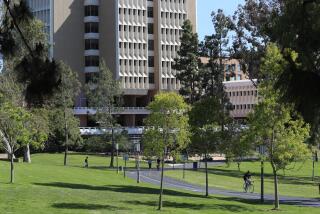IRVINE : UCI Appoints Chief of Ophthalmology
- Share via
After more than two years without a chairman of its ophthalmology department, the UC Irvine College of Medicine has appointed a 57-year-old laser expert whose goal is to build a major eye institute on campus.
In addition to winning the $80,000-a-year job, Dr. Richard H. Keates has been given the Irving Leopold Chair in ophthalmology, an endowed chair named after the previous department chairman. The Leopold Chair will provide Keates about $50,000 a year in research funds.
Also, UCI’s Beckman Laser Institute is buying a $280,000 ultraviolet laser for Keates’ use and assigning him two research assistants. Keates plans to use the laser in experimental procedures to “sculpt” the corneas of both nearsighted and farsighted people to correct their vision.
Keates vowed Monday to step up the pace of UCI’s outpatient visits, begin surgeries at the Beckman Institute as well as at UCI Medical Center in Orange and, by July, convert office space in the campus medical building to four operating rooms.
He expressed the hope of finding private and corporate donors to build a $20-million eye institute on campus--a clinical and research facility that would rival UCLA’s Jules Stein and Doheny eye institutes.
“Since this school is totally surrounded by major eye companies or medical device companies--Allergan, Alcon, Optimal Radiation, Chyron Ophthalmic--I want to set up here a diagnostic and trial center” which would allow medical firms to test new products at UCI, Keates said. (While continuing his new post at UCI, Keates also expects to continue working about once a month as as a consultant for Chyron.)
In announcing Keates’ appointment, Dr. Walter Henry, dean of UCI’s medical school, praised his energy and described him as “an excellent clinical ophthalmologist” who is also an “innovator.” Henry said he hoped a UCI eye institute would be part of a larger neuroscience center.
In 20 years as a professor at Ohio State University, Keates was one of the first Americans to use the “Yag” laser to open membranes in the eye after cataract surgery, thus avoiding a second operation. He also designed and developed bifocal intra-ocular lens transplants, supervised Ohio State’s eye bank and helped develop methods of preserving corneas for transplantation.
Keates said that in the latter role he earned the nickname “Captain Midnight.” Because donor corneas frequently arrived late in the day and had to be used immediately, “we always used to operate late at night,” he said. But once doctors learned how to preserve corneal tissue for up to seven days, they could work normal hours.






